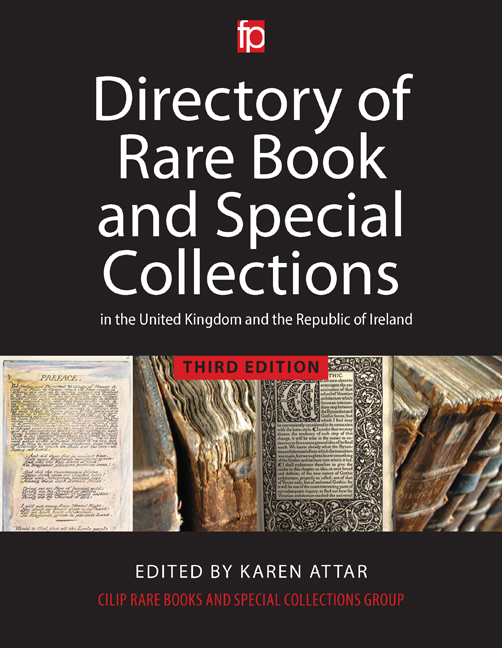Book contents
- Frontmatter
- Contents
- Dedication
- Foreword
- Rare Books and Special Collections Group Foreword
- Introduction
- Bibliography and webography
- Selected list of abbreviations and acronyms
- England
- Northern Ireland
- Republic of Ireland
- Scotland
- Wales
- Crown Dependencies
- Appendix 1 Possible special collections
- Appendix 2 English counties
- Index of libraries
- Index of collectors
- Index of subjects
Introduction
Published online by Cambridge University Press: 08 June 2018
- Frontmatter
- Contents
- Dedication
- Foreword
- Rare Books and Special Collections Group Foreword
- Introduction
- Bibliography and webography
- Selected list of abbreviations and acronyms
- England
- Northern Ireland
- Republic of Ireland
- Scotland
- Wales
- Crown Dependencies
- Appendix 1 Possible special collections
- Appendix 2 English counties
- Index of libraries
- Index of collectors
- Index of subjects
Summary
‘The basic aim of the Directory is to bring to the notice of scholars and researchers the location of rare book collections in libraries in the United Kingdom and the Republic of Ireland, and to provide such information about their nature, size and importance as will enable them to assess whether or not further investigation is likely to be to their benefit.’
Thus Wrotemoelwyn I. Williams, editor of the first edition of the Directory of Rare Book and Special Collections in the United Kingdom and Republic of Ireland (1985), in his introduction to that work (p. ix), and the aim holds good for the third edition in 2016. The Directory brings together descriptions of collections of at least 50 items based on the printed word across all sorts of repositories throughout the British Isles: national libraries; academic libraries; public (i.e. local authority) libraries; subscription libraries; professional and other independent libraries; company libraries; libraries in trusts, staTELy homes, London clubs, cathedrals, churches, monasteries, schools, archives, museums, and even a prison. It answers such questions as: ‘Where do I find 16th-century French imprints? / Civil War pamphlets / a concentration of Kelmscott Press books / Victorian books about railways?’, and assists researchers to plan their work: ‘Must I go to London for a concentration of Penguin books, or can I go to Manchester or Edinburgh?’ ‘Is Thomas Carlyle's library preserved intact and available in the public sphere?’.
It is a directory of collections, not a catalogue of individual books: it is anticipated that anybody seeking for specific titles will look in the usual sources, such as the Incunabula Short Title Catalogue (ISTC), the English Short Title Catalogue (ESTC) (both of which contain books not catalogued online by particular libraries), Copac, and the catalogues of specific libraries. Information will sometimes be far less detailed than that given on the websites of individual contributing repositories; what the Directory does is to bring everything together.
The continued need for a directory of collections, as more and more books are catalogued online, is clear partly from interest in features which do not readily emerge from catalogues, with their traditional emphasis on finding specific titles or works by a particular author or on a particular subject, and especially not from union catalogues: provenances, bindings, publishers, and so forth.
- Type
- Chapter
- Information
- Publisher: FacetPrint publication year: 2016

